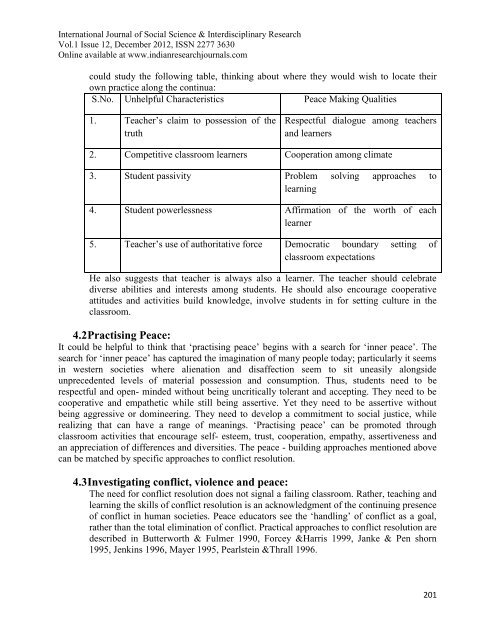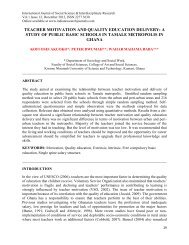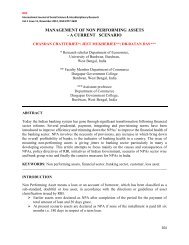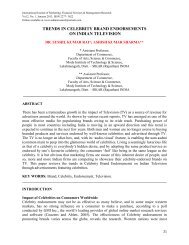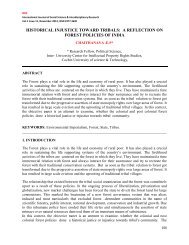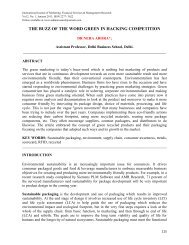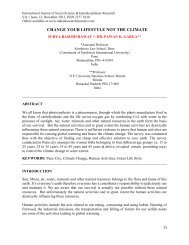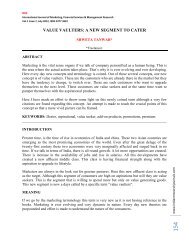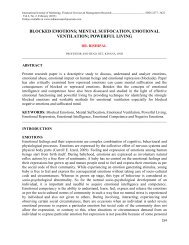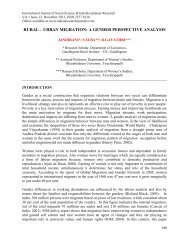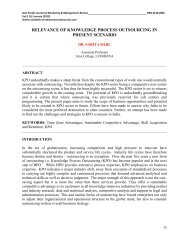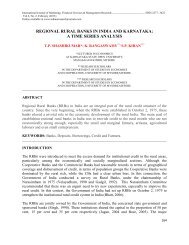PEACE EDUCATION AND HUMAN RIGHTS IN TWENTY FIRST ...
PEACE EDUCATION AND HUMAN RIGHTS IN TWENTY FIRST ...
PEACE EDUCATION AND HUMAN RIGHTS IN TWENTY FIRST ...
Create successful ePaper yourself
Turn your PDF publications into a flip-book with our unique Google optimized e-Paper software.
International Journal of Social Science & Interdisciplinary Research<br />
Vol.1 Issue 12, December 2012, ISSN 2277 3630<br />
Online available at www.indianresearchjournals.com<br />
could study the following table, thinking about where they would wish to locate their<br />
own practice along the continua:<br />
S.No. Unhelpful Characteristics Peace Making Qualities<br />
1. Teacher‟s claim to possession of the<br />
truth<br />
Respectful dialogue among teachers<br />
and learners<br />
2. Competitive classroom learners Cooperation among climate<br />
3. Student passivity Problem solving approaches to<br />
learning<br />
4. Student powerlessness Affirmation of the worth of each<br />
learner<br />
5. Teacher‟s use of authoritative force Democratic boundary setting of<br />
classroom expectations<br />
He also suggests that teacher is always also a learner. The teacher should celebrate<br />
diverse abilities and interests among students. He should also encourage cooperative<br />
attitudes and activities build knowledge, involve students in for setting culture in the<br />
classroom.<br />
4.2 Practising Peace:<br />
It could be helpful to think that „practising peace‟ begins with a search for „inner peace‟. The<br />
search for „inner peace‟ has captured the imagination of many people today; particularly it seems<br />
in western societies where alienation and disaffection seem to sit uneasily alongside<br />
unprecedented levels of material possession and consumption. Thus, students need to be<br />
respectful and open- minded without being uncritically tolerant and accepting. They need to be<br />
cooperative and empathetic while still being assertive. Yet they need to be assertive without<br />
being aggressive or domineering. They need to develop a commitment to social justice, while<br />
realizing that can have a range of meanings. „Practising peace‟ can be promoted through<br />
classroom activities that encourage self- esteem, trust, cooperation, empathy, assertiveness and<br />
an appreciation of differences and diversities. The peace - building approaches mentioned above<br />
can be matched by specific approaches to conflict resolution.<br />
4.3 Investigating conflict, violence and peace:<br />
The need for conflict resolution does not signal a failing classroom. Rather, teaching and<br />
learning the skills of conflict resolution is an acknowledgment of the continuing presence<br />
of conflict in human societies. Peace educators see the „handling‟ of conflict as a goal,<br />
rather than the total elimination of conflict. Practical approaches to conflict resolution are<br />
described in Butterworth & Fulmer 1990, Forcey &Harris 1999, Janke & Pen shorn<br />
1995, Jenkins 1996, Mayer 1995, Pearlstein &Thrall 1996.<br />
201


